Gaetano Lapis (1706-1773) was an Italian painter of the late-Baroque period.
Contents


Gaetano Lapis (1706-1773) was an Italian painter of the late-Baroque period.


Lapis was born on 13 August 1706 in the central Italian city of Cagli, the son of Filippo Lapis, a wool merchant, and his wife Olimpia Orlandini of Cantiano. [1] [2] [3]
He moved to Rome at a young age and, after a brief apprenticeship with Cristoforo Creo, entered the workshop of Sebastiano Conca, whom he may have met in 1720 when Conca was working on his Madonna and Child with Saint Teresa in Cagli Cathedral. Lapis later moved to the workshop of Conca's cousin Giovanni Conca. [4]
In his 1787 biography of Lapis, Giovanni Gherardo De Rossi records that Sebastiano Conca "was fond of his new pupil and taught him with devotion even though he saw he was adopting a style totally different from the one he adhered to". [5] During his time in Conca's workshop he was given the nickname Il Carraccetto, a reference to the influence of Bolognese masters of the previous century such as Carracci, Guido Reni and Domenichino. [6]
Lapis became a member of the Academy of the Virtuosi in 1739, and in 1741 he was introduced by Sebastiano Conca as a member of the Accademia di San Luca. [7] By 1754 he was living permanently in Rome. [8] The list of his pupils includes Antonio Cavallucci. [9]
From 1766 he was commissioned by Cardinal Scipione Borghese (1734-1782) and his brother Marcantonio IV Borghese (1730-1780) to work on modernizing the church of Santa Caterina da Siena a Via Giulia and then of Palazzo Borghese in Rome. [10]
A document in the archive of the Accademia di San Luca records the funeral expenses for the "late academician Gaetano Lapis", indicating that he died in April 1773.

Sebastiano Conca was an Italian painter.

The Accademia di San Luca is an Italian academy of artists in Rome. The establishment of the Accademia de i Pittori e Scultori di Roma was approved by papal brief in 1577, and in 1593 Federico Zuccari became its first principe or director; the statutes were ratified in 1607. Other founders included Girolamo Muziano and Pietro Olivieri. The Academy was named for Luke the Evangelist, the patron saint of painters.

Antonio Cavallucci was an eighteenth-century Italian painter of religious scenes and portraits.

Cagli is a town and comune in the province of Pesaro e Urbino, Marche, central Italy. It is c. 30 kilometres south of Urbino. The Burano flows near the town.
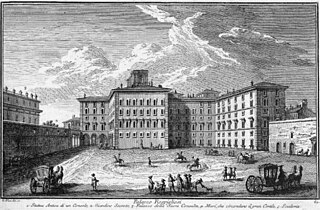
The Palazzo Pallavicini-Rospigliosi is a palace in Rome, Italy. It was built by the Borghese family on the Quirinal Hill; its footprint occupies the site where the ruins of the baths of Constantine stood, whose remains still are part of the basement of the main building, the Casino dell'Aurora. Its first inhabitant was the famed art collector Cardinal Scipione Borghese, the nephew of Pope Paul V, who wanted to be housed near the large papal Palazzo Quirinale. The palace and garden of the Pallavicini-Rospigliosi were the product of the accumulated sites and were designed by Giovanni Vasanzio and Carlo Maderno in 1611–16. Scipione owned this site for less than a decade, 1610–16, and commissioned the construction and decoration of the casino and pergolata, facing the garden of Montecavallo. The Roman palace of this name should not be mistaken for the panoramic Villa Pallavicino on the shores of Lake Como in Lombardy. The Palace has also been the scene of important cultural and religious events. On June 6, 1977 Princess Elvina Pallavicini invited in Palazzo Pallavicini Rospigliosi the archbishop monsignor Marcel Lefebvre for a conference on the Second Vatican Council and for the celebration of a Traditiona Mass, under the careful direction of the marquis Roberto Malvezzi, and Frigate Captain marquis Luigi Coda Nunziante di San Ferdinando. Many members of Alleanza Cattolica, the baron Roberto de Mattei, the pharmacologist Giulio Soldani, the sociologist Massimo Introvigne, the psychiatrist Mario Di Fiorino and Attilio Tamburrini and his brother Renato Tamburrini took part to the event.

Santi Marcellino e Pietro al Laterano is a Roman catholic parish and titular church in Rome on the Via Merulana. One of the oldest churches in Rome, it is dedicated to Saints Marcellinus and Peter, 4th century Roman martyrs, whose relics were brought here in 1256.

Giuseppe Bartolomeo Chiari, also known simply as Giuseppe Chiari, was an Italian painter of the late-Baroque period, active mostly in Rome.

Giuseppe Nicola Nasini was an Italian painter of the Baroque period and active in Rome and Tuscany.

Francesco Mancini was an Italian painter whose works are known between 1719 and 1756. He was the pupil of Carlo Cignani.

Jacopo Zoboli was an Italian painter.
Claudio Francesco Beaumont was an Italian painter, active in a late baroque-style mostly in the Piedmont region.
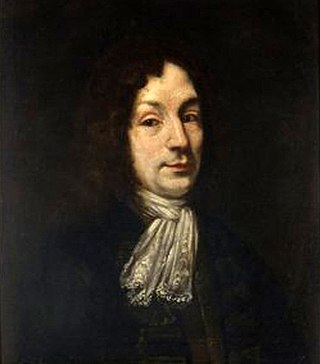
Luca Antonio Predieri was an Italian composer and violinist. A member of a prominent family of musicians, Predieri was born in Bologna and was active there from 1704. In 1737 he moved to Vienna, eventually becoming Kapellmeister to the imperial Habsburg court in 1741, a post he held for ten years. In 1765 he returned to his native city where he died two years later at the age of 78. A prolific opera composer, he was also known for his sacred music and oratorios. Although his operas were largely forgotten by the end of his own lifetime and most of their scores lost, individual arias as well some of his sacred music are still performed and recorded.

Tommaso Minardi was an Italian painter and author on art theory, active in Faenza, Rome, Perugia, and other towns. He painted in styles that transitioned from Neoclassicism to Romanticism.
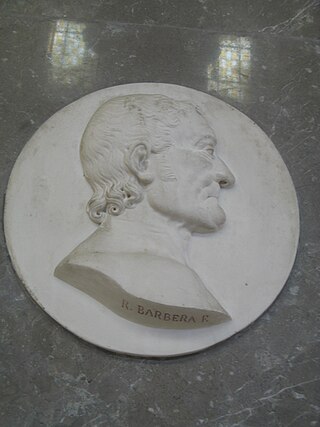
Giuseppe Velasquez, Velasques or Velasco was an Italian painter, active in a Neoclassic style.
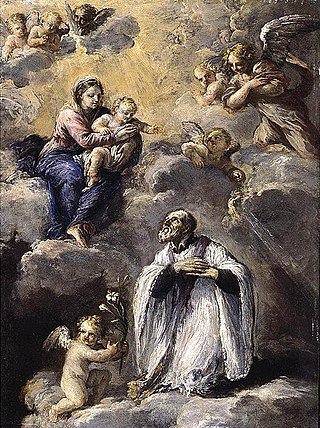
Ludovico Stern was an Italian painter of the Rococo or late-Baroque period, active in Rome. He is known for both large sacred and history paintings, as well as still lives, and portraits.

San Francesco is a Gothic-style, Roman Catholic, Franciscan church in Cagli, province of Pesaro e Urbino, region of Marche, Italy.

Cagli Cathedral is a Roman Catholic cathedral in the town of Cagli, in the province of Pesaro and Urbino, region of Marche, Italy, dedicated to the Assumption of the Virgin Mary. It was formerly the episcopal seat of the Diocese of Cagli; since 1986 it has been a co-cathedral in the Diocese of Fano-Fossombrone-Cagli-Pergola. It was granted the status of a minor basilica in 1982.
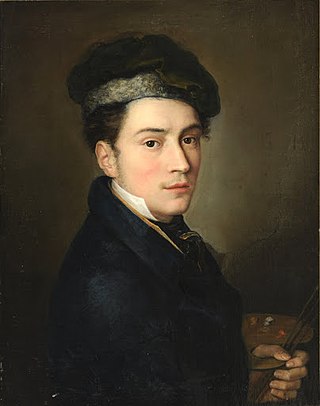
Pietro Gagliardi was an Italian painter and architect, who decorated many churches and palaces in Rome and throughout Italy.
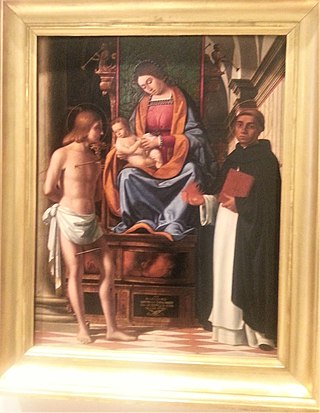
Madonna and Child with Saint Sebastian and Saint Vincent Ferrer or Madonna and Child with Saint Sebastian and Saint Thomas Aquinas is an oil on panel painting by Andrea Previtali. It was produced in 1506 in Venice while he was still in the studio of Giovanni Bellini and is contemporary with the same artist's Madonna and Child. It is now in the Accademia Carrara in Bergamo, to which it passed from Guglielmo Lochis's collection in 1866.

Piero or Pietro Paolo Vasta was an Italian painter of the Baroque period, mainly active in the east of his native Sicily.